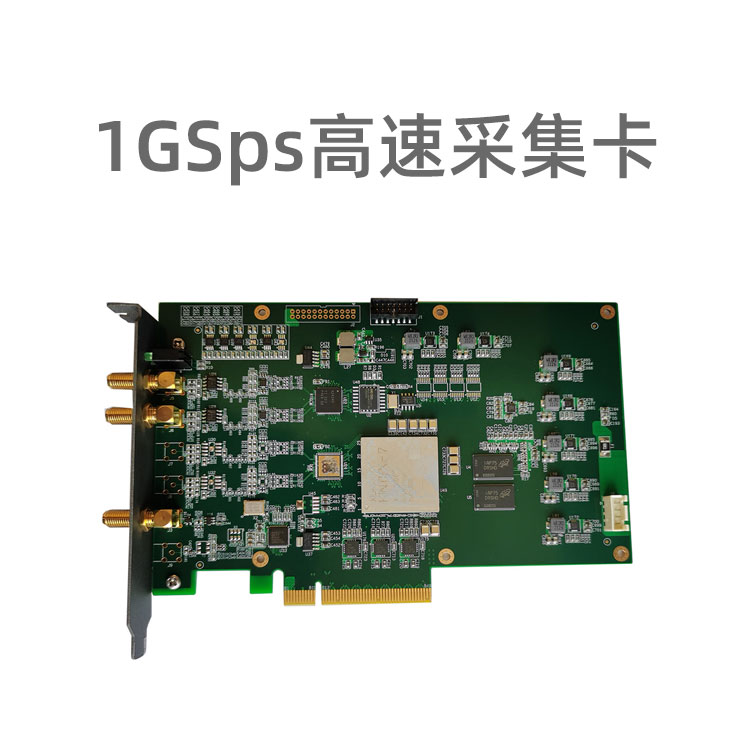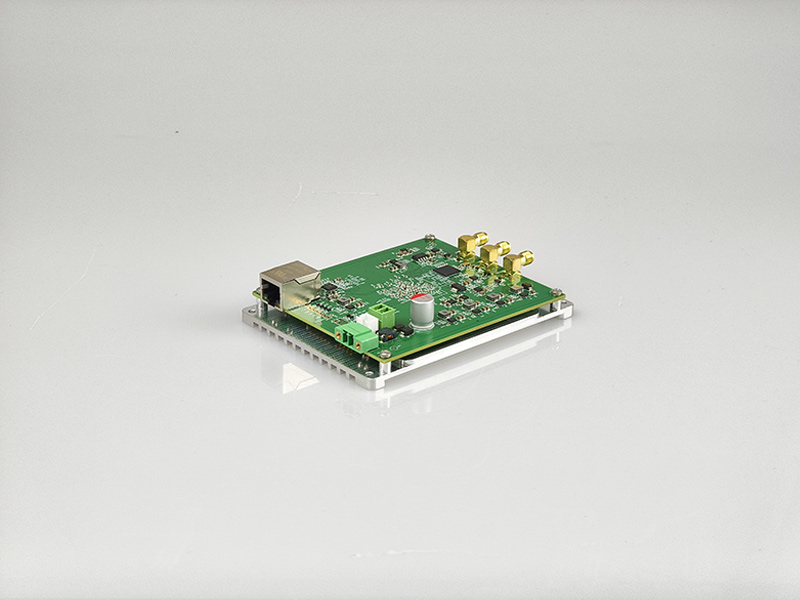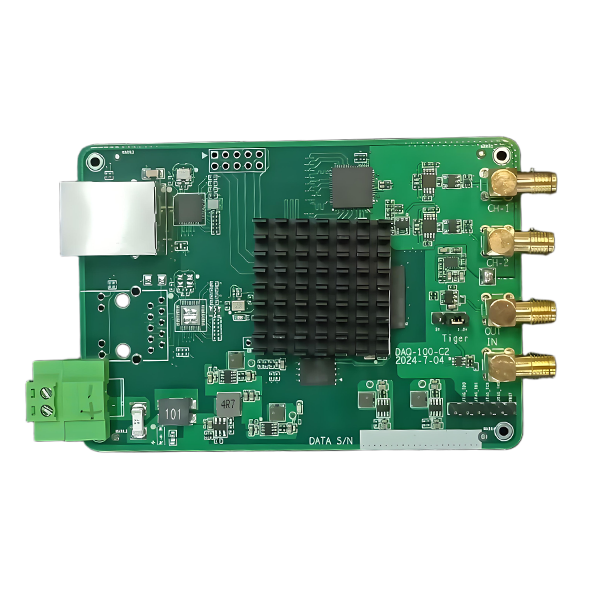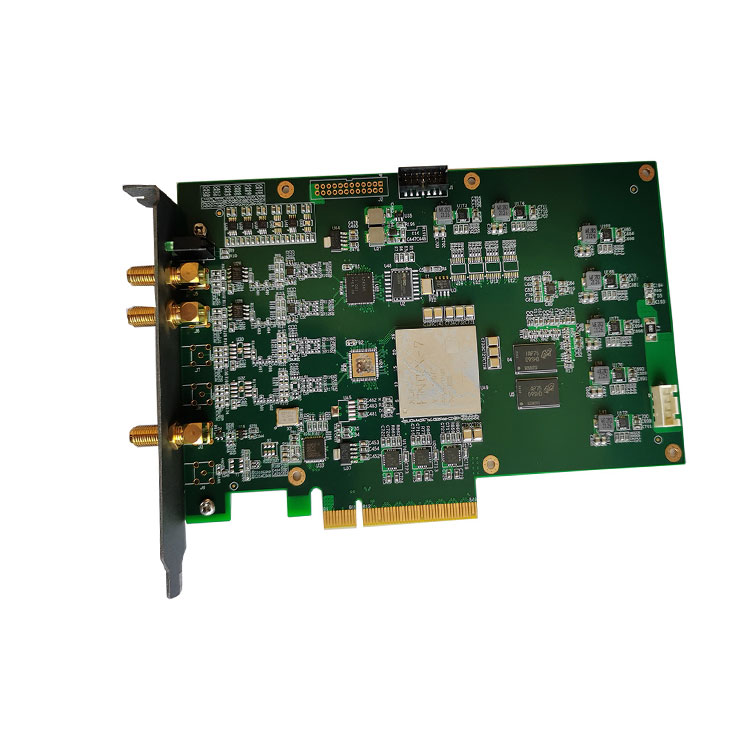
1GSps dual-channel high-speed data acquisition card
1GSps high speed data acquisition card for applications such as fiber optic sensing systems or LIDAR systems.
 Huang
Email: Hqy@ybphotonics.com
Huang
Email: Hqy@ybphotonics.com
 Download>>
Download>>
Product Info
Introduction
The DAQ board, which can be set up to 1G sample rate and has built-in trigger output and input interfaces, can be used for applications such as DAS distributed acoustic sensing system with 200M AOM acquisition or LIDAR.
This is a PCIe x8 Lane, dual channel, 16bits respectively rate high speed data acquisition card with 1GSps sampling rate. high performance FPGA chip on board with rich multiplier and RAM resources. The driver has good compatibility and supports multiple versions of WIN7, WIN8, WIN10 in 32/64bits.
Description of built-in algorithms
YB-DAS-1000-DAQ has a built-in IQ demodulation function for balanced detector DAS systems, supporting both single-channel and dual-channel IQ demodulation. The simultaneous upload rate can be configured as 1G, 500M, 250M, 125M, 83.33M, 62.5M, 50M and so on.
It supports three data upload modes: single-channel, dual-channel and four-channel. When using single-channel mode, the number of points per frame (the number of points collected by a single trigger pulse) can support a maximum of 262144 points, i.e., a single optical fiber length in 1G (0.1m spatial resolution) upload rate, a maximum of 262144 * 0.1m = 26.2144 kilometers; if the upload rate is reduced, a longer length of fiber can be supported. longer fiber lengths can be supported;
Features
- 16bits dual-channel simultaneous real-time sampling
- 1GSps sampling rate
- DC coupling, 50Ω input impedance
- 1.9Vpp input voltage range, 0-250MHz analog bandwidth
- Up to 89dBc SFDR
- Trigger output pulse, 16-channel digital IO
- Support for triggered outputs and inputs
- PCI Express x8 Lane high-speed transfer interface
- 2GB DDR3 cache
Specifications
Input Channel
Number of input channels
2
Input Impedance
50±1%
Ω
Input Signal Range
1.9Vp-p
Input coupling method
DC(Customizable AC coupling)
Resolution
16
bits
Bandwidth(-3dB)
0-250 (other bandwidths can be customized)
MHz
Spurious-free dynamic range(SFDR)
-1dBFS Input/1GSps
fIN=100MHz
86
dBc
fIN=170MHz
88
dBc
Signal-to-noise ratio(SNR)
-1dBFS Input/1GSps
fIN=100MHz
70.6
dBFS
fIN=170MHz
71.5
dBFS
Average noise density
-142
dBm/Hz
Internal reference clock
Frequency
10
MHz
Stability
±0.5(-20-60℃)
ppm
Trigger output
High level minimum voltage
3 (50Ω load)
V
Pulse width resolution
4
nS
Minimum pulse width
4
nS
Digital input/output
Number of channels
16
Leveling standards
3.3V LVTTL
Output drive capability
8(MAX)
mA
Signal Rate
50(MAX)
Mbps
On-Board Cache
2
GB(DDR3L)
Power supply and consumption- Power supply voltage: 12V (gold finger power supply)
- Power consumption: 20W (Max)
Temperature range
- Working temperature:-20~60℃
- Storage temperature:-40~85℃
Mechanical dimensions
- 181mm(L) x 111mm(W)x20mm(D)
Order Information
GY-DAS-1000-DAQ-X
Firmware version X Description
V1 Defualt。
Supports Winodws operating systems and discrete graphics cards, but not Linux operating systems
V2 Both Windows and Linux operating systems are supported, but not discrete graphics cards.
The default is version V1, if you need to run on Linux operating system, then please choose version V2. But the V2 version does not does not support discrete graphics cards.
API Description
The DAQ board provides an API in the form of a dynamic link library (.dll file), which can be called in your favorite programming language (Python, C++, C#, Java or Libview, etc.).
int pcie7820_set_upload_data_param(unsigned int upload_ch_num,unsigned int upload_data_src,unsigned int upload_data_rate)
function description:
Set up the board upload data parameters. Digital downconversion has been done on the board to perform digital I/Q demodulation of the collected data. The upload_ch_num parameter and upload_data_src are used together to select where in the demodulation algorithm to read the data.
function parameter:
upload_ch_num :Set the number of channels to upload;
1 - upload one channel of data; 2 - upload two channels of data; 4 - upload four channels of data;
upload_data_src:Upload data source selection;
0 - upload raw acquisition data; 2 - upload IQ data; 3 - upload phase and magnitude data;
upload_data_rate:Sets the upload data rate;
1---1GSps;2---500MSps;4---250MSps;8---125MSps;12---83.333MSps;16---62.5MSps;20---50MSps;24---41.66MSps;28---35.714MSps;32---31.25MSps;
The data read by the pcie7820_read_data function should be parsed according to the following table:
编号 upload_ch_num upload_data_src Uploaded data Upload data parsing rules 1 1 0 Raw data captured on channel 0 ch0_raw_data--- ch0_raw_data --- ch0_raw_data --- ch0_raw_data--- 2 1 2 I data for channel 0 after low-pass filtering I0---I0----I0---I0…… 3 1 3 Channel 0 demodulated phase data arctan(Q0/I0)--- arctan(Q0/I0)--- arctan(Q0/I0)--- arctan(Q0/I0)--- 4 2 0 Raw data captured on channels 0 and 1 ch0_raw_data--- ch1_raw_data --- ch0_raw_data --- ch1_raw_data…… 5 2 2 I and Q data of channel 0 after low-pass filtering I0---Q0---I0----Q0…… 6 2 3 Channel 0 demodulated phase and amplitude data arctan(Q0/I0)---√(I02+Q02)--- arctan(Q0/I0)---√(I02+Q02)… 7 4 0 unsupported unsupported 8 4 2 I and Q data of channels 0 and 1 after low-pass filtering I0---Q0---I1----Q1---I0---Q0---I1----Q1…… 9 4 3 Phase and amplitude data after demodulation of channels 0 and 1 arctan(Q0/I0)---√(I02+Q02)--- arctan(Q1/I1)---√(I12+Q12)--- arctan(Q0/I0)---√(I02+Q02)--- arctan(Q1/I1)---√(I12+Q12)…
ch0_raw_data---ch1_raw_data---I0---Q0---I1----Q1--- arctan(Q0/I0)--- arctan(Q1/I1),These 8 types of data need to be parsed as 16-bit signed data (short).;√(I02+Q02)---√(I12+Q12),These two types of data need to be parsed as 16-bit unsigned short numbers.
The arctan phase value read up is a fixed point number, and its correspondence with π is: 25735 - positive π, -25735 - negative π.
If you need more detailed interface documentation, please inquire.
DAQ Programming Examples
# -*- coding: utf-8 -*-
from ctypes import *
import numpy as np
from time import sleep
import datetime
dll = cdll.LoadLibrary("./pcie7820_64bits_api.dll")
samples = 1024 #采样点数
flag = True
def open_card():
print('Open...')
dll.pcie7820_open() #open
def init_daq_card():
print('Configure card...')
dll.pcie7820_set_trig_dir(c_uint(1)) #Setting the trigger pulse input/output direction
dll.pcie7820_set_scan_rate(c_double(1000)) #Setting the trigger pulse output frequency 1kHz
dll.pcie7820_set_pusle_width(c_uint(100)) #Setting the high level width of the trigger pulse, 100ns
dll.pcie7820_set_upload_data_param(c_uint(1), c_uint(0), c_uint(1)) #Set number of channels to 1, raw data, 1GSps;
dll.pcie7820_set_points_num_per_scan(c_uint(samples)) #Setting the number of sampling points
dll.pcie7820_set_center_freq(c_uint(200000000)) #Setting the AOM
print("Config end")
def start():
flag = True
print('Start...')
dll.pcie7820_start()
def stop():
flag = True
print('Stop...')
dll.pcie7820_stop()
def close():
print('Close...')
dll.pcie7820_close() #先stop 再close
def read_data():
n_frames = 200
size = c_uint(0)
buf = (c_int16*samples*n_frames)()
flag = True
i=0
start_time = datetime.datetime.now()
while flag:
status_query = dll.pcie7820_point_num_per_ch_in_buf_query(byref(size))
print(f"query.. {size.value}, {status_query=}")
#print(size)
if size.value >=samples*n_frames:
print('Read data...')
status_read = dll.pcie7820_read_data(c_uint(samples*n_frames), buf, byref(size))
""" if size.value!=samples*100:
continue """
ndata = np.frombuffer(buf, dtype=np.int16)
# print(f"Data size: {np.size(ndata)}")
print(f"Start Time: {start_time}, Current Time: {datetime.datetime.now()} - Acquisition number {i}, {status_read=}")
#unwrap code ....
#flag = False
i = i + 1
if i >= 1000000:
flag = False
if status_read == -1:
break
else:
sleep(0.1) #wait...
def run():
open_card()
init_daq_card()
start()
read_data()
stop()
close()
if __name__ == '__main__':
run()
The DAQ board, which can be set up to 1G sample rate and has built-in trigger output and input interfaces, can be used for applications such as DAS distributed acoustic sensing system with 200M AOM acquisition or LIDAR.
This is a PCIe x8 Lane, dual channel, 16bits respectively rate high speed data acquisition card with 1GSps sampling rate. high performance FPGA chip on board with rich multiplier and RAM resources. The driver has good compatibility and supports multiple versions of WIN7, WIN8, WIN10 in 32/64bits.
Description of built-in algorithms
YB-DAS-1000-DAQ has a built-in IQ demodulation function for balanced detector DAS systems, supporting both single-channel and dual-channel IQ demodulation. The simultaneous upload rate can be configured as 1G, 500M, 250M, 125M, 83.33M, 62.5M, 50M and so on.
It supports three data upload modes: single-channel, dual-channel and four-channel. When using single-channel mode, the number of points per frame (the number of points collected by a single trigger pulse) can support a maximum of 262144 points, i.e., a single optical fiber length in 1G (0.1m spatial resolution) upload rate, a maximum of 262144 * 0.1m = 26.2144 kilometers; if the upload rate is reduced, a longer length of fiber can be supported. longer fiber lengths can be supported;
Features
- 16bits dual-channel simultaneous real-time sampling
- 1GSps sampling rate
- DC coupling, 50Ω input impedance
- 1.9Vpp input voltage range, 0-250MHz analog bandwidth
- Up to 89dBc SFDR
- Trigger output pulse, 16-channel digital IO
- Support for triggered outputs and inputs
- PCI Express x8 Lane high-speed transfer interface
- 2GB DDR3 cache
Specifications
| Input Channel | ||
|---|---|---|
| Number of input channels | 2 | |
| Input Impedance | 50±1% | Ω |
| Input Signal Range | 1.9Vp-p | |
| Input coupling method | DC(Customizable AC coupling) | |
| Resolution | 16 | bits |
| Bandwidth(-3dB) | 0-250 (other bandwidths can be customized) | MHz |
| Spurious-free dynamic range(SFDR) | -1dBFS Input/1GSps | |
| fIN=100MHz | 86 | dBc |
| fIN=170MHz | 88 | dBc |
| Signal-to-noise ratio(SNR) | -1dBFS Input/1GSps | |
| fIN=100MHz | 70.6 | dBFS |
| fIN=170MHz | 71.5 | dBFS |
| Average noise density | -142 | dBm/Hz |
| Internal reference clock | ||
| Frequency | 10 | MHz |
| Stability | ±0.5(-20-60℃) | ppm |
| Trigger output | ||
| High level minimum voltage | 3 (50Ω load) | V |
| Pulse width resolution | 4 | nS |
| Minimum pulse width | 4 | nS |
| Digital input/output | ||
| Number of channels | 16 | |
| Leveling standards | 3.3V LVTTL | |
| Output drive capability | 8(MAX) | mA |
| Signal Rate | 50(MAX) | Mbps |
| On-Board Cache | 2 | GB(DDR3L) |
- Power supply voltage: 12V (gold finger power supply)
- Power consumption: 20W (Max)
Temperature range
- Working temperature:-20~60℃
- Storage temperature:-40~85℃
Mechanical dimensions
- 181mm(L) x 111mm(W)x20mm(D)
Order Information
GY-DAS-1000-DAQ-X
| Firmware version X | Description |
|---|---|
| V1 | Defualt。 Supports Winodws operating systems and discrete graphics cards, but not Linux operating systems |
| V2 | Both Windows and Linux operating systems are supported, but not discrete graphics cards. |
The default is version V1, if you need to run on Linux operating system, then please choose version V2. But the V2 version does not does not support discrete graphics cards.
API Description
The DAQ board provides an API in the form of a dynamic link library (.dll file), which can be called in your favorite programming language (Python, C++, C#, Java or Libview, etc.).
int pcie7820_set_upload_data_param(unsigned int upload_ch_num,unsigned int upload_data_src,unsigned int upload_data_rate)
function description:
Set up the board upload data parameters. Digital downconversion has been done on the board to perform digital I/Q demodulation of the collected data. The upload_ch_num parameter and upload_data_src are used together to select where in the demodulation algorithm to read the data.
function parameter:
upload_ch_num :Set the number of channels to upload;
1 - upload one channel of data; 2 - upload two channels of data; 4 - upload four channels of data;
upload_data_src:Upload data source selection;
0 - upload raw acquisition data; 2 - upload IQ data; 3 - upload phase and magnitude data;
upload_data_rate:Sets the upload data rate;
1---1GSps;2---500MSps;4---250MSps;8---125MSps;12---83.333MSps;16---62.5MSps;20---50MSps;24---41.66MSps;28---35.714MSps;32---31.25MSps;
The data read by the pcie7820_read_data function should be parsed according to the following table:
| 编号 | upload_ch_num | upload_data_src | Uploaded data | Upload data parsing rules |
|---|---|---|---|---|
| 1 | 1 | 0 | Raw data captured on channel 0 | ch0_raw_data--- ch0_raw_data --- ch0_raw_data --- ch0_raw_data--- |
| 2 | 1 | 2 | I data for channel 0 after low-pass filtering | I0---I0----I0---I0…… |
| 3 | 1 | 3 | Channel 0 demodulated phase data | arctan(Q0/I0)--- arctan(Q0/I0)--- arctan(Q0/I0)--- arctan(Q0/I0)--- |
| 4 | 2 | 0 | Raw data captured on channels 0 and 1 | ch0_raw_data--- ch1_raw_data --- ch0_raw_data --- ch1_raw_data…… |
| 5 | 2 | 2 | I and Q data of channel 0 after low-pass filtering | I0---Q0---I0----Q0…… |
| 6 | 2 | 3 | Channel 0 demodulated phase and amplitude data | arctan(Q0/I0)---√(I02+Q02)--- arctan(Q0/I0)---√(I02+Q02)… |
| 7 | 4 | 0 | unsupported | unsupported |
| 8 | 4 | 2 | I and Q data of channels 0 and 1 after low-pass filtering | I0---Q0---I1----Q1---I0---Q0---I1----Q1…… |
| 9 | 4 | 3 | Phase and amplitude data after demodulation of channels 0 and 1 | arctan(Q0/I0)---√(I02+Q02)--- arctan(Q1/I1)---√(I12+Q12)--- arctan(Q0/I0)---√(I02+Q02)--- arctan(Q1/I1)---√(I12+Q12)… |
ch0_raw_data---ch1_raw_data---I0---Q0---I1----Q1--- arctan(Q0/I0)--- arctan(Q1/I1),These 8 types of data need to be parsed as 16-bit signed data (short).;√(I02+Q02)---√(I12+Q12),These two types of data need to be parsed as 16-bit unsigned short numbers.
The arctan phase value read up is a fixed point number, and its correspondence with π is: 25735 - positive π, -25735 - negative π.
If you need more detailed interface documentation, please inquire.
DAQ Programming Examples
# -*- coding: utf-8 -*-
from ctypes import *
import numpy as np
from time import sleep
import datetime
dll = cdll.LoadLibrary("./pcie7820_64bits_api.dll")
samples = 1024 #采样点数
flag = True
def open_card():
print('Open...')
dll.pcie7820_open() #open
def init_daq_card():
print('Configure card...')
dll.pcie7820_set_trig_dir(c_uint(1)) #Setting the trigger pulse input/output direction
dll.pcie7820_set_scan_rate(c_double(1000)) #Setting the trigger pulse output frequency 1kHz
dll.pcie7820_set_pusle_width(c_uint(100)) #Setting the high level width of the trigger pulse, 100ns
dll.pcie7820_set_upload_data_param(c_uint(1), c_uint(0), c_uint(1)) #Set number of channels to 1, raw data, 1GSps;
dll.pcie7820_set_points_num_per_scan(c_uint(samples)) #Setting the number of sampling points
dll.pcie7820_set_center_freq(c_uint(200000000)) #Setting the AOM
print("Config end")
def start():
flag = True
print('Start...')
dll.pcie7820_start()
def stop():
flag = True
print('Stop...')
dll.pcie7820_stop()
def close():
print('Close...')
dll.pcie7820_close() #先stop 再close
def read_data():
n_frames = 200
size = c_uint(0)
buf = (c_int16*samples*n_frames)()
flag = True
i=0
start_time = datetime.datetime.now()
while flag:
status_query = dll.pcie7820_point_num_per_ch_in_buf_query(byref(size))
print(f"query.. {size.value}, {status_query=}")
#print(size)
if size.value >=samples*n_frames:
print('Read data...')
status_read = dll.pcie7820_read_data(c_uint(samples*n_frames), buf, byref(size))
""" if size.value!=samples*100:
continue """
ndata = np.frombuffer(buf, dtype=np.int16)
# print(f"Data size: {np.size(ndata)}")
print(f"Start Time: {start_time}, Current Time: {datetime.datetime.now()} - Acquisition number {i}, {status_read=}")
#unwrap code ....
#flag = False
i = i + 1
if i >= 1000000:
flag = False
if status_read == -1:
break
else:
sleep(0.1) #wait...
def run():
open_card()
init_daq_card()
start()
read_data()
stop()
close()
if __name__ == '__main__':
run()


